Horse Guards is a majestic building that is most famous for the sentries who guard the entrance to the Horse Guards Parade, a parade ground that is the scene of the daily ceremonial changing of guards.
Horse Guards
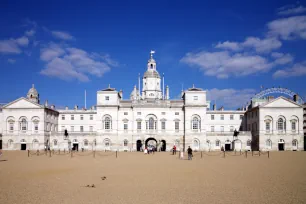
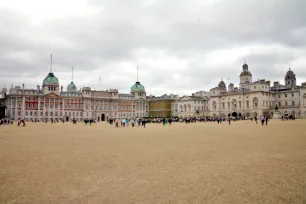
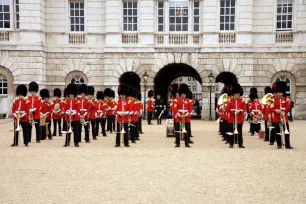
The Palladian-style building was designed in 1745 by William Kent. After Kent died three years later, he was succeeded by John Vardy, who completed the Horse Guards building in 1755. Until 1872 this was the headquarters of the Commander-in-Chief of the British army.
Horse Guards forms a grand entrance to the famous Horse Guards Parade and St. James’s Park beyond. During daytime, the building’s arched passage on Whitehall is guarded by both mounted and unmounted troopers of the Household Cavalry regiments, who are often the target of camera-wielding tourists.
Inside the Horse Guards is the Household Cavalry Museum, which gives visitors insight into the history and current activities of the Household Cavalry, which was formed in 1661 by order of King Charles II to protect the monarch. The museum displays a variety of objects such as ceremonial uniforms and musical instruments. The building is still in active use and through a glass screen you can get a glimpse of the activity in the stables.
Horse Guards Parade
Behind the Horse Guards and accessed through a triple-arched gateway lies the Horse Guards Parade, one of the largest open spaces in central London. The parade ground was first used during the reign of King Henry VIII, when jousting tournaments were held here. His Whitehall Palace, which was destroyed by fire in 1698, overlooked the parade ground.
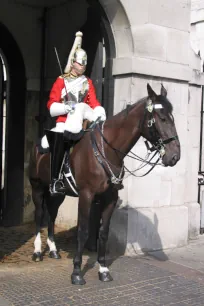
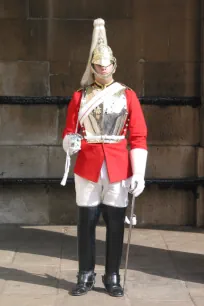
The Horse Guards Parade is bordered by buildings on three sides. To the north is the monumental Old Admiralty Building, built in the nineteenth century as an expansion of the original eighteenth-century headquarters of the Royal Navy. Opposite the Old Admiralty Building is 10 Downing Street, the official office of the Prime Minister. On the west side, the parade ground opens up towards St. James’s Park.
The Horse Guards Parade is best known for its Changing of the Guard and Inspection by the Officer of the Guards ceremonies, which occur daily. The Horse Guards building provides the perfect background for these events, which always draw a crowd. The Changing of the Guard takes place daily at 11.00 am (10.00 am on Sundays). During the ceremony, which is similar to that at Buckingham Palace and lasts about thirty minutes, mounted members of the King’s Life Guard relieve the sentries. The Inspection by the Officer takes place at 16:00 and ends with the horses being led back to their stables.
There are also two annual ceremonies that take place here and show Britain’s affinity for royal pomp and circumstance at its finest: the Trooping of the Colour and Beating Retreat. The Trooping of the Colour was originally a military parade that goes back to the seventeenth century. Since 1748 it has been held to celebrate the birthday of the monarch, a tradition that continues today. Another annual event that takes place on the parade ground is the Beating Retreat, a military ceremony that was first performed in the sixteenth century to call units back to their base. Today it is a purely symbolic ceremony featuring marching bands and even a fireworks’ finale.
Monuments
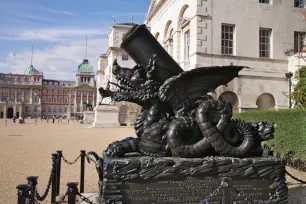
There are several interesting monuments and memorials on Horse Guards Parade. The most eye-catching is the Cádiz Memorial, made from a French mortar that was given by the Spanish government out of gratitude for the raising of the siege of Cádiz in 1812 by the Duke of Wellington. The mortar rests on the back of a massive sculpture of a Chinese dragon. A similar but less bombastic monument is the nearby Turkish cannon from the sixteenth century that was captured in Egypt in 1801.
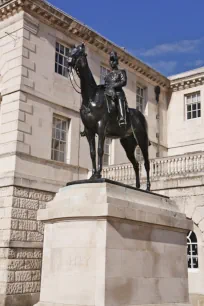
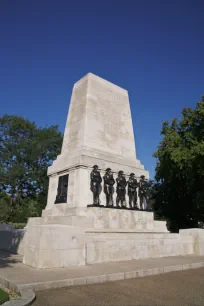
There are also three statues on Horse Guards Parade. On the south side is the statue of Horatio Kitchener, unveiled in 1926. Kitchener was Secretary of State during the First World War, but is most famous for the army recruitment poster which featured his face.
Near the gateway stand two equestrian statues. On the left is the statue of Garnet Joseph Wolseley, unveiled in 1920. Wolseley was a field marshal who during the nineteenth century served in virtually all corners of the British Empire. To the right is the equestrian statue of Frederick Sleigh Roberts, another nomadic field marshal who enjoyed military successes in India and South Africa.
On the west side of the parade ground, just inside St. James’s Park, is the Guards Division Memorial, which commemorates members of the guards regiments who died during the World Wars. The memorial was inaugurated in 1926. It was designed by the architect Harold Chalton Bradshaw. The five bronze figures, made by Gilbert Ledward, represent the different regiments.
Finally, on the north side, the Royal Naval Division Memorial commemorates the members of the Royal Naval Division who perished in the First World War. The division was created in 1914 to supplement the infantry forces of the British army with members of the naval reserve force. The division was disbanded in 1919, after the war.
The memorial was designed by Edwin Lutyens and was unveiled in 1925. In 1939, it was removed to make way for the Admiralty Citadel, a bomb-proof communications center that was built during the Second World War. In 1951 the memorial was installed in Greenwich, but it returned in 2003. The memorial consists of an obelisk set in a fountain basin that rests on a pedestal.

